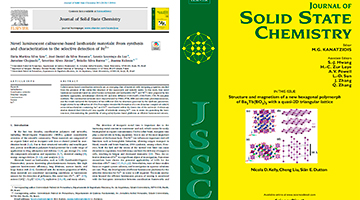 SupraMMat SupraMMat
SupraMMat SupraMMat
 News News
News News
New Paper!
Check out our first paper of 2021!

Calix[n]arene-based coordination networks are an emerging class of materials with intriguing properties resulted from the presence of the cavity-like structure of the macrocycle and metallic nodes. In this work, four novel luminescent materials based on calix[4]arene-carboxylate and lanthanides (Eu3þ and Tb3þ) were prepared by two synthetic approaches, solvothermal (CDA-Eu-ST) and slow diffusion (CDA-Eu-RT, CDA-Tb-RT, CTA-Tb-complex) methods. The coordination networks were characterized by PXRD, FTIR, SEM and solid-state photoluminescence, and the results indicated the formation of two different CDA-Eu-structures governed by the synthesis parameters. Single-crystal X-ray diffraction of CTA-Tb-complex revealed the formation of a new dinuclear complex of calix[4]arene-tetracarboxylate containing Naþ and Tb3þ coordinated within the lower rim of the molecule. Preliminary studies showed that CDA-Eu-RT was capable of selectively sensing Fe3þ ions in water via quenching the luminescence, demonstrating the possibility of using calix[4]arene-based platforms as efficient luminescent sensors.
I.M. Silva Lins, J. Daniel da Silva Fonseca, L. Lourenço da Luz, J. Chojnacki, S.A. Júnior, B.S. Barros, J. Kulesza, Novel luminescent calixarene-based lanthanide materials: From synthesis and characterization to the selective detection of Fe3+, J. Solid State Chem. 295 (2021). doi:10.1016/j.jssc.2020.121916.






